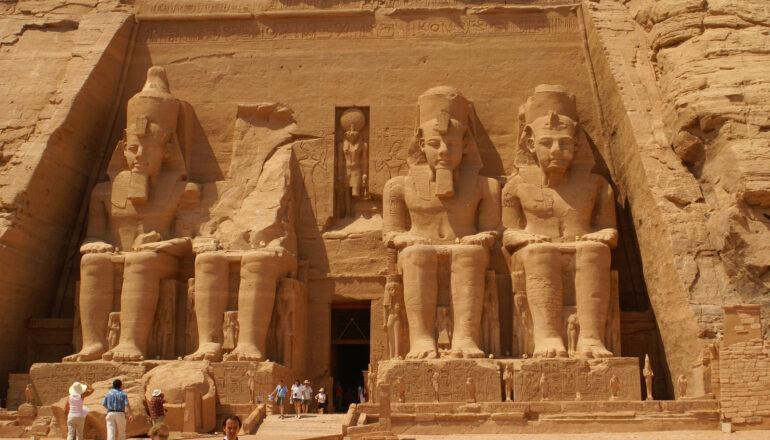Abu Simbel is a historical site in southern Egypt, featuring two massive rock-cut temples built during the reign of Pharaoh Ramses II in the 13th century BC. These temples not only honor Ramses II and his queen Nefertari but also serve as a testament to ancient Egyptian art and engineering. The complex was relocated in the 1960s to prevent it from being submerged by the creation of Lake Nasser due to the Aswan High Dam.
The Timeless Grandeur of Abu Simbel
Nestled on the western bank of Lake Nasser, in the Aswan Governorate of southern Egypt, lies the awe-inspiring archaeological site of Abu Simbel. This site is home to two massive rock-cut temples that stand as a testament to the grandeur of ancient Egypt and the ingenuity of its people.
The history of Abu Simbel dates back to the 13th century BC, during the reign of Pharaoh Ramses II. These temples were not only a symbol of the Pharaoh’s power but also a monument to his beloved wife, Queen Nefertari. The larger of the two temples features four colossal statues of Ramses II, each standing over 20 meters tall, designed to instill awe in the hearts of visitors and subjects alike.
The discovery of Abu Simbel in modern times is as fascinating as its history. Buried under sand for centuries, it was rediscovered in 1813 by Swiss explorer Johann Ludwig Burckhardt and later excavated by Giovanni Battista Belzoni in 1817. This rediscovery brought to light the rich legacy of ancient Egyptian art and architecture.
One of the most remarkable features of Abu Simbel is the alignment of the Great Temple. Twice a year, on approximately February 22 and October 22, the sun’s rays penetrate the inner sanctum to illuminate the statues of Ramses II and the gods to whom the temple is dedicated. This solar phenomenon attracts thousands of visitors and highlights the precision with which the ancient Egyptians aligned their monumental structures.
In the 1960s, the temples faced the threat of submersion due to the construction of the Aswan High Dam. In an unprecedented international effort led by UNESCO, the temples were carefully cut into large blocks, dismantled, and moved to a higher location. This successful rescue operation is considered one of the greatest achievements in archaeological history.
Today, Abu Simbel stands as a UNESCO World Heritage Site, drawing visitors from around the globe. It remains a powerful symbol of Egypt’s enduring legacy and continues to be a source of inspiration and wonder for all who gaze upon its ancient stones.
For those unable to visit in person, images of Abu Simbel capture the essence of its magnificence. The towering figures of Ramses II, the intricate carvings, and the play of light and shadow over the millennia-old sandstone tell a story of a civilization that continues to fascinate the world.
Abu Simbel remains a beacon of the past, reminding us of the incredible achievements of human creativity and perseverance. It stands not just as a relic of history, but as a bridge connecting us to the rich tapestry of human culture that spans across time and geography. Whether in person or through images, the experience of Abu Simbel is truly unforgettable.



